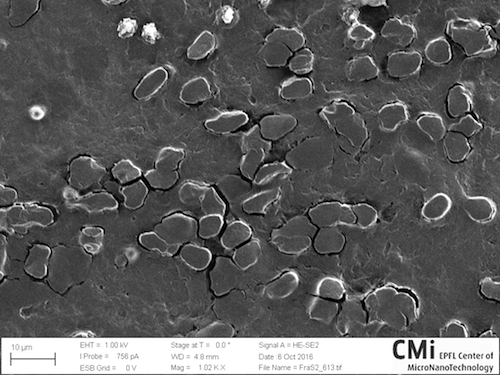
Integrated Sensing Architectures and Tools for Health Care
People
| Giovanni De Micheli LSI Director and Professor |
||
| Sandro Carrara MER |
Biomedical circuits and systems | |
| Mathias Soeken Post-doctoral Researcher |
||
| Heinz Riener Post-doctoral Researcher |
||
| Francesca Criscuolo PhD Student |
PhD project: Wearable multi-sensing platform for ion-sensing |
|
| Ivan Ny Hanitra PhD Student |
PhD project: Integrated and Programmable Multi-Sensing Electrochemical Platform |
|
| Cunxi Yu Post-doctoral Researcher |
Decision making Support |
Vision
This research project addresses high-risk, high-reward research of integrated sensing and computing architectures, as well as of models, methods and tools for their design and operation. Such architectures provide the bridge between bio-systems and information processing systems, where a bio-system is an abstraction of a human in terms of biophysical parameters. Breakthroughs in data acquisition, processing and decision making support will enable new smart-health applications.
The essential research goals of this proposal are: biophysical data acquisition by novel programmable integrated sensor arrays and their design and test using a modular and structured architecture; data processing in situ and/or remotely using application-specific hardware and/or embedded software; a new robust synthesis methodology for data processing units based on a new logic structure; models, abstractions and software tools for reasoning about the acquired data, to validate health conditions and/or to provide remedies (i.e., therapy). The results of this research will be embodied in a demonstrator showing the effectiveness of these combined technologies in first-aid medical care.
The outcome of this research will have a deep and broad impact on health care, because it will improve diagnosis and therapy in a variety of cases. Namely, it will boost the quality and quantity of the acquired biophysical data, possibly in real time, by leveraging multiple sensing modalities and dedicated computing architectures. The use of formal methods for design, data evaluation and decision making support will enhance the quality of the diagnostic platforms and will ease their qualification and adoption. Moreover, the integration of sensing and electronics and their in-field programmability will reduce production cost and lower the barrier of adoption, thus providing for better and more affordable health care means.
Portable electrochemical multi-sensing platform for immunohematology
Part of this project addresses the realization of a portable electrochemical multi-sensing platform that can perform both qualitative and quantitative blood analysis to ensure safe blood transfusions in emergency situations. A portable system will be crucial in monitoring hemolytic diseases of the fetus and the newborn (HDFN, or simply HDN) in outpatient cases. Hemolytic disease is still a major cause of fetal and newborn losses today. Nowadays this condition attacks 1/300 – 1/600 pregnant women. Prevention consists of monitoring the possible sensitization of the mother by quantitatively analyzing her serum antibodies during pregnancy. If the antibodies increase significantly, an exchange transfusion in utero or in the newborn period can be necessary. The device should thus be able to perform complete and accurate blood typing and to determine the amount of specific blood group antibodies in the samples.

Sensors for blood typing
Wearable multi-sensing platform for ion-sensing
This part of the project aims at the fabrication of a general-purpose portable multi-sensing platform for ion-sensing for different healthcare purposes. Sweat will be used as main sample fluid because it represents a promising substitute to blood thanks to the simple artificial reproducibility and to the large accessibility that does not require invasive or painful procedures. Its diagnostic potential has already been demonstrated in several research works for different applications. Some commercial examples are also available nowadays. The device will be realised on a flexible headband to ensure conformability and direct sweat uptake. The platform will also be implemented in a rigid format. The design will include a temperature sensor and sensing sites for different target ions for different applications including Therapeutic Drug Monitoring (TDM), toxicology, exercise and healthcare monitoring.

Wearable multi-sensing platform for ion-sensing
Data processing circuits
This work aims the realization of an integrated and general-purpose multi-sensing electrochemical platform, for wearable or point-of-care applications. Hybrid and low-power circuit architectures are developed to monitor different target analytes that are sensed through a biosensor array. Moreover, sensing numerous compounds necessitates efficient data processing tools to predict reliably the concentration of each individual compound.
Logic structures for data processing
Medical applications, like others, require high throughput data processing. Hardware for data processing benefits from threshold and majority logic gates. A new design methodology with this primitives exploits logic models, algorithms and tools. An important objective of this research is to create a library of logic transformations and a design tool for optimizing networks, with strong support for arithmetic functions that can outperform existing methods and be placed in the public domain. Thus we study both theoretical and pragmatic issues of majority logic. An extended set of publications ishere.
Data evaluation and decision making support
We have introduced a general model for medical injection system, which can be applied to both simulation and formal verification, using Satisfiability Modulo Theory (SMT) over Reals. The mathematical three-compartment pharmacokinetics model is used for drug response in the abstract timed model, which is one of the most precise pharmacokinetics models for simulating drug response.
The model is demonstrated that it can efficiently and precisely simulate the medical injection process. The model can formally prove(disprove) if the expected drug concentration-time objectives are reachable ewith given injection actions, and return sat/unsat by checking bounded δ-satisfiability.
The proposed model computes AUC and constrained AUC simultaneously during the verification or simulation process. For computing constrained AUC, we have introduced an algorithm based on proof of unsatisfiability of SMT over real numbers.